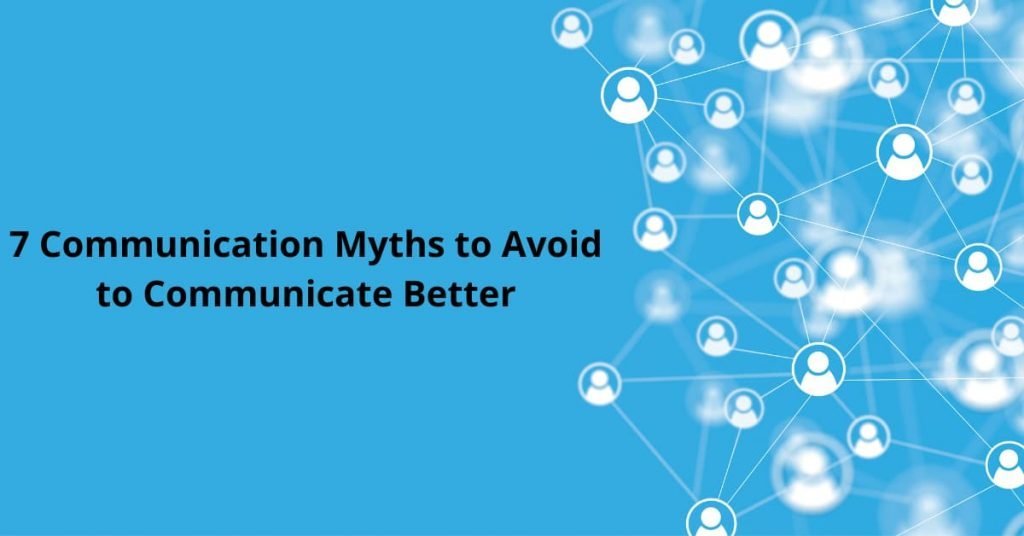The art of communication is a tricky skill to navigate. You need to be able to give enough information to be understood. Unfortunately, this does not always happen. We make assumptions about our communication skills and the ability of others to understand.
Communication is ‘the act of conveying information’ yet many people are unclear how to convey information effectively. Below are some common myths with myth-busting tips for improving your communication:
Myth 1: Communication is about talking or writing
Communication is more than just speaking or writing. Some individuals, particularly those who are deaf, rely on visual communication too. However, there are many people who believe that if you get a response then a message has been communicated. There are others who respond too quickly so do not fully understand the information being given to them.
When a message is given to us, our brain needs time to process the information. Our brain uses a number of biases as filters to work out the meaning. So if we respond without fully listening, our emotional centre (the amygdala) responds, not the part of the brain that processes information. So, my tip is to listen and understand, not listen to reply. Responding comes later after you fully understand the information being conveyed.
Myth 2: Communication just happens
To ‘assume’ makes an ‘ass’ of ‘u’ and ‘me’. Just because you open your mouth and say something or put something in writing does not mean you have conveyed information that will be understood. It is a good idea to get someone else to check that what you want to say (or write) is clear.
My additional note to this is to ask someone who is ‘different’ to you. We all have differences – cultural, age, gender and so on. If you are going to convey information to a wide range of people, avoid checking with someone who is like you. Get a true sense of whether the information is understood – ask someone who is outside your normal ‘in-group’.
Myth 3: We all use the same language so everyone should understand
It is wonderful that some people want to play linguistic gymnastics with information but ‘keep it simple’ works wonders too. People don’t want to waste time trying to decipher acronyms or work specific jargon. Time is money and life is short, so keep it simple.

Myth 4: Everyone got the email so they’re in the loop
Don’t ‘assume’ your emails have been received or have been understood. Communication is about checking that everyone has received information and understands it.
Myth 5: There is no time for questions
I honestly believe there is no such thing as a stupid question. There is always that one person who attends meetings then constantly asks questions throughout, winding everyone up because the answers seem obvious or the questions seem trivial. Questioning is how people develop critical analysis skills. They are also a good indicator that someone is actively listening because they are trying to make sense of information within their own understanding. So, encourage questions. If you don’t like people asking questions, then you probably need communication training.
Myth 6: Visual information has limited value
The brain actually processes visual information far quicker than sound. Visuals are a significantly better way of conveying information than text. This is why social media apps like Snapchat and Instagram work – a picture paints a thousand words. Flow charts, graphs, timelines and maps all help with conveying information. Using colours for key information can also make information clearer. Visuals can help you avoid misunderstanding. So, if information can be conveyed visually, then use visuals instead of text.
Myth 7: Videos communicate our message
Subtitles, subtitles, subtitles! I cannot say this enough. Vlogs, videos on your website or in presentations need to include subtitles. Some of us may well appreciate your dulcet tones. However, your message is important. Why waste time creating videos that are inaccessible? Second language users, people with hearing loss, or people that don’t want to use the sound on their media device, can’t hear what you have to say. Why go to all that effort for nothing!? My simple tip is that subtitles go with video just as strawberries go with cream.
Great communication
You can achieve great communication if you take the time to think about how you convey messages. If you can use visuals so that information is accessible, then you can also include a wider range of people in your message.
More importantly, listening to others will help you understand the messages you receive.
“The single biggest problem in communication is the illusion that it has taken place”
George Bernard Shaw
Do you have any suggestions for communication tips? Comments are most welcome.

